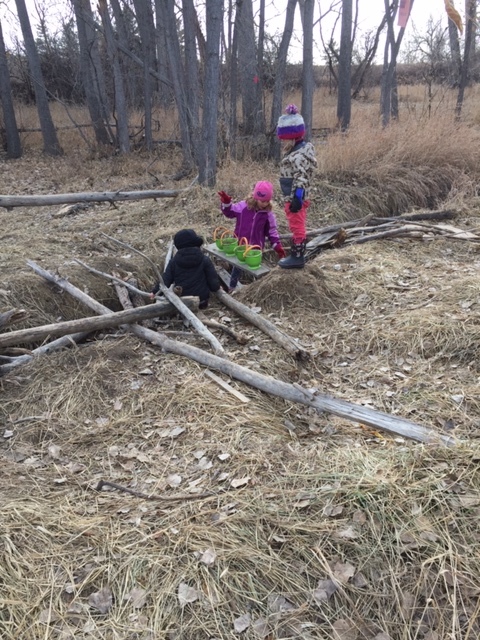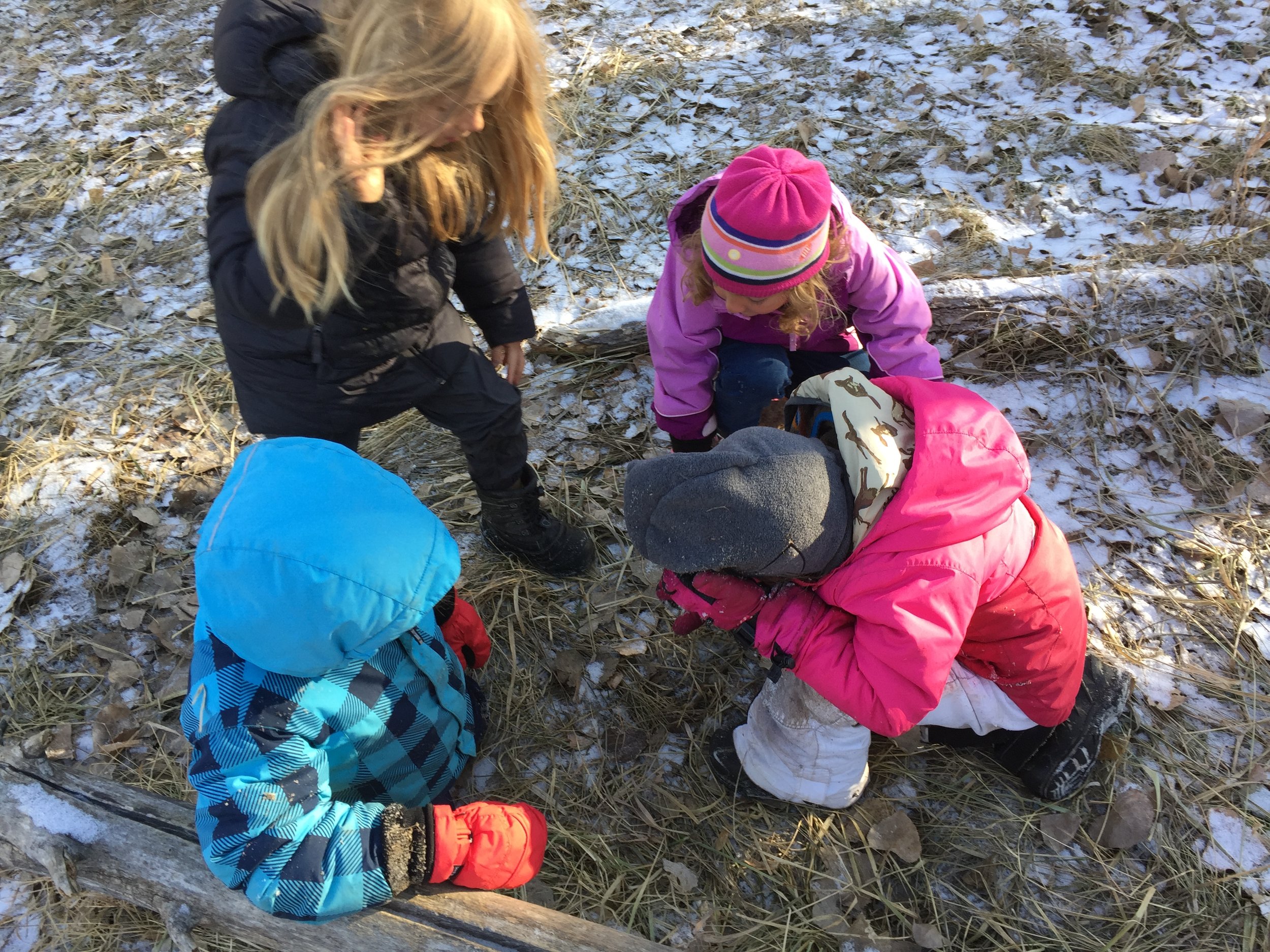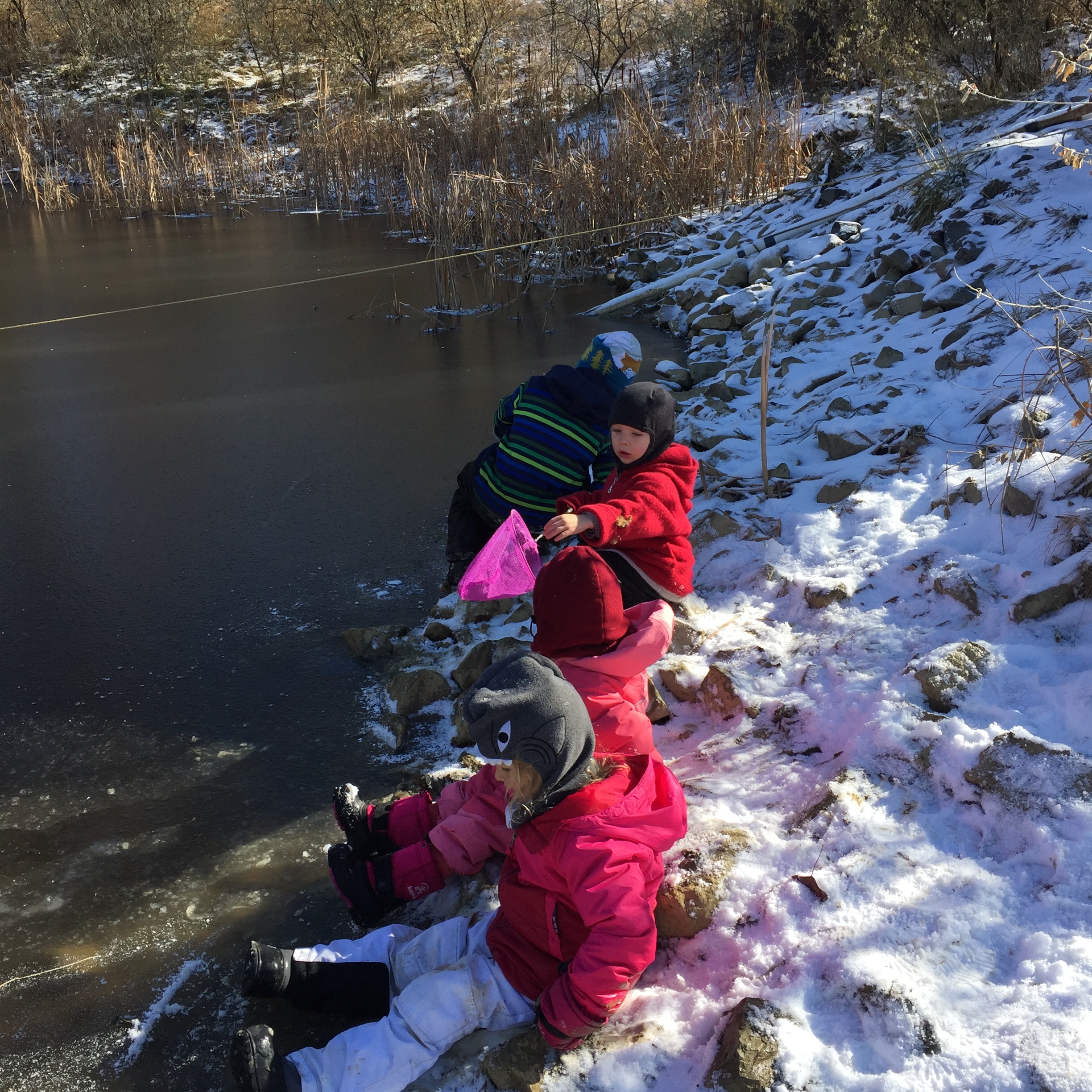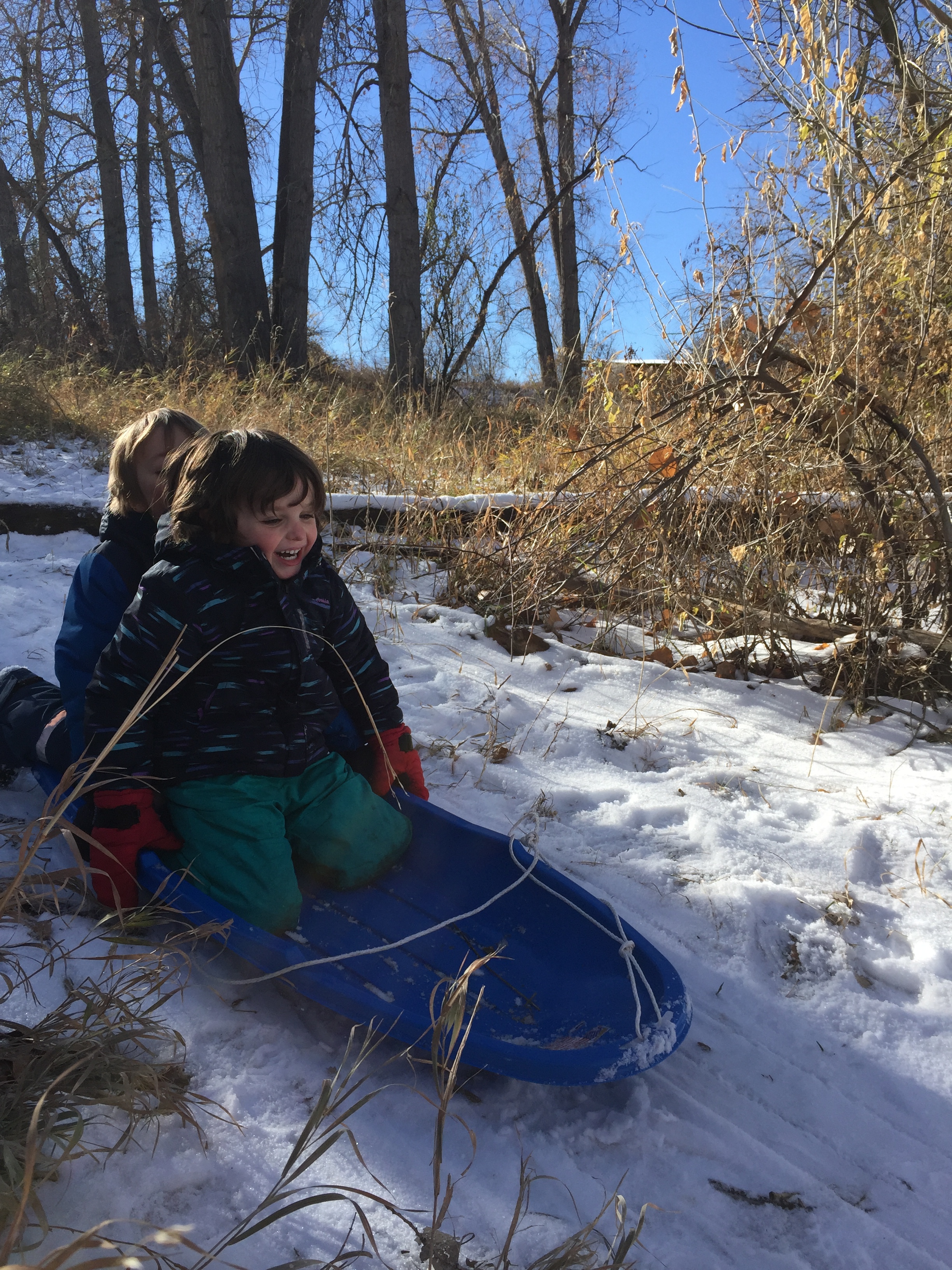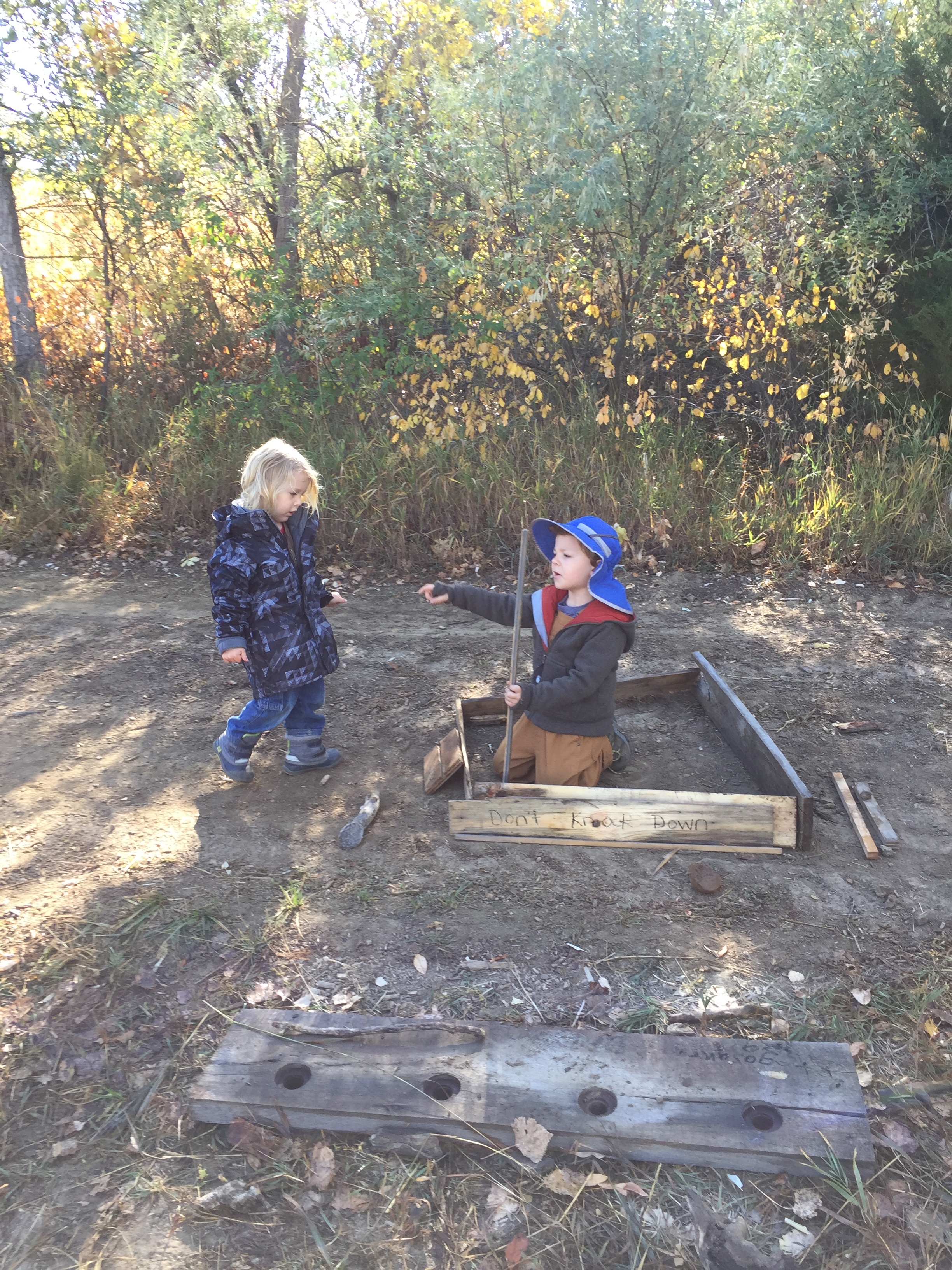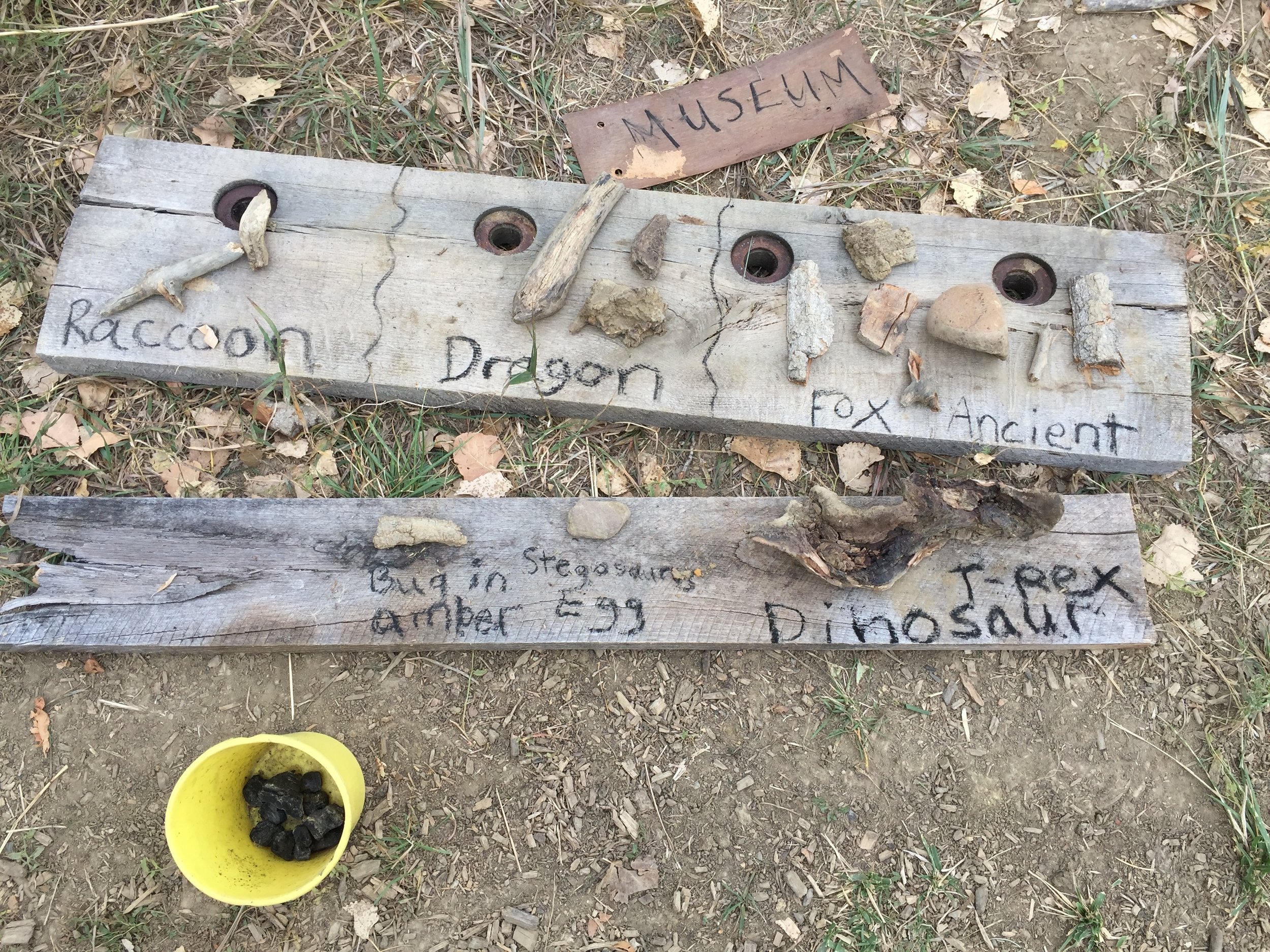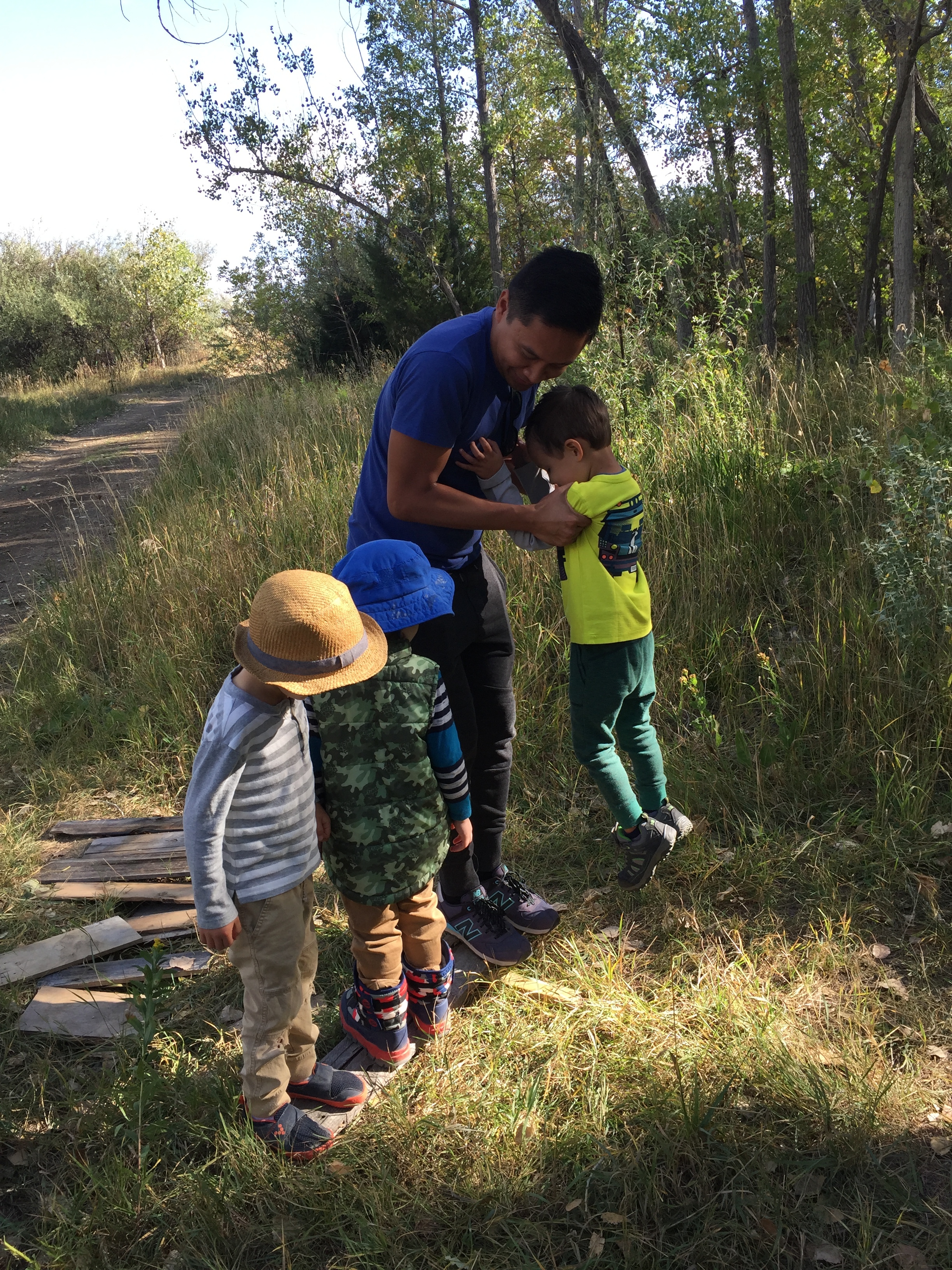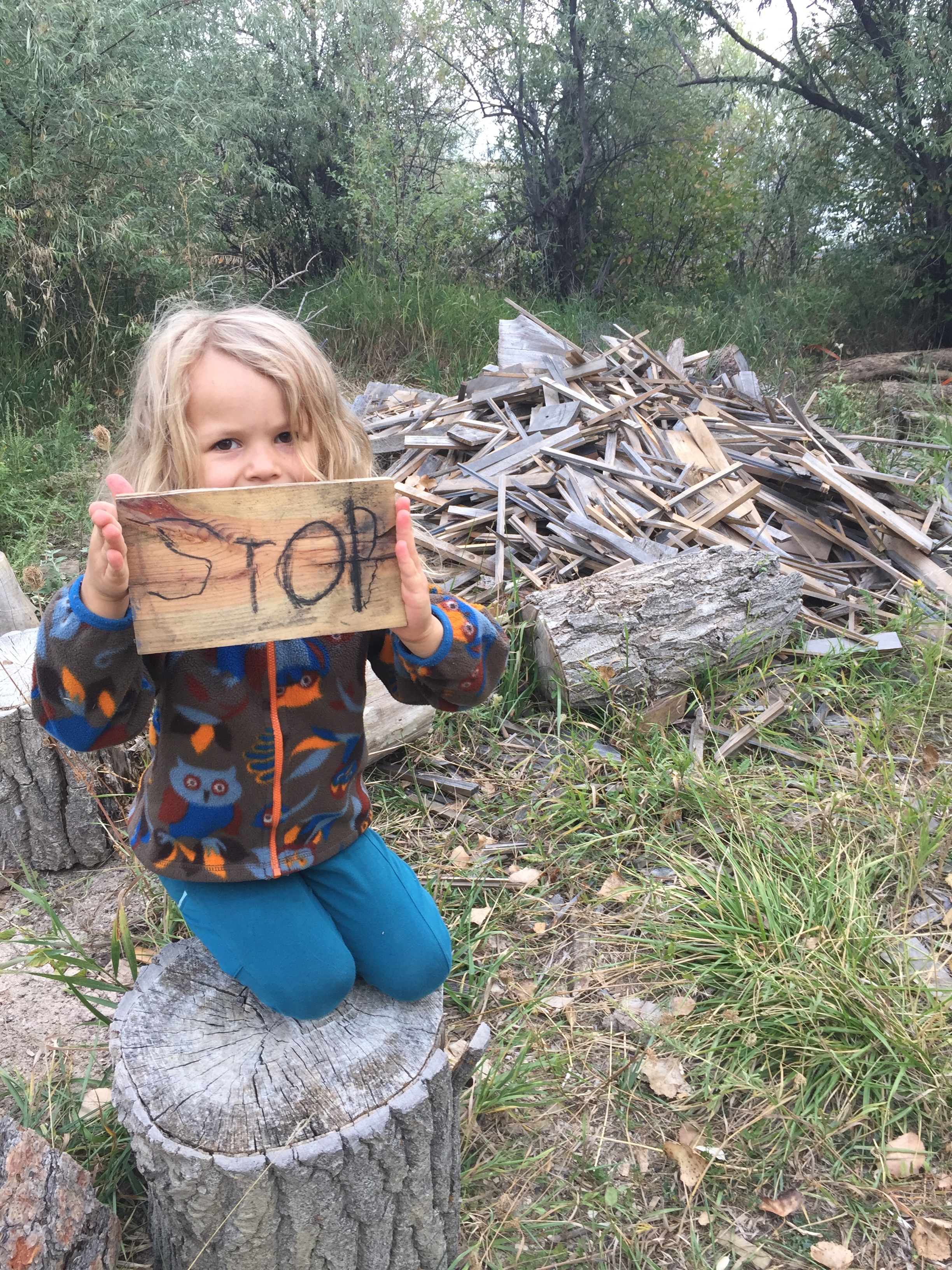
Mid-Winter Greetings!
We are now about halfway through our wonderful winter season here at Contrast Farm. As can be expected in a place with variable weather, we have had quite the sampler of precipitation along with sunny and snowy days, gusty winds here and there, and even sleet (our Friday group has shown a lot of grit on those days!) We have found that the best clothing for wet days is a rain suit layered over snow gear—that way the insulated pants and jackets do not become soaked-through and heavy with water. Thank you all for sending oodles of extra mittens—I told the children I should give myself a new name: Mrs. Mittens! We are becoming pretty adept at getting thumbs into their correct homes. Checking fingers and toes and making sure everyone is dry and warm is a big part of our winter days. We also recommend taking a look to see if your child’s boots are still fitting properly—they should not fit snugly, because a little extra room allows for wool socks and that lovely pocket of warm air that keeps wiggling toes warmer.
These daring kids are taking appropriate risks by experimenting with building a jump on our very gentle sledding slope. They soon discovered two things: it is hard to aim a sled toward a narrow target and our slope is too gradual to build up enough speed. Regardless, the kids spent a good deal of time on these discoveries and the excitement of the project created an overlap between two interest-groups when our dramatic play kiddos gravitated toward the action.
Winter is a time when the connection between ourselves and the forest become most apparent. The weather plays an immense role in how the children play and interact. On the days when the sleet was falling on our forest, the children instinctively knew to keep themselves moving. On those days, our older children ran and leaped and chased each other. On warm days, we have seen the children slow down and take time to have long conversations or stay in one place to work on a project. Because of the variation in weather, our days don’t flow in the same way they did in autumn. Themes that the children are interested in weave in and out of our days rather than on a weekly continuum. For example, in our warmer months the children were heavily focused on building. They had their hands free from mittens and the ground and lumber were soft and workable. These projects haven’t disappeared, however…when we have those warm winter days the kids will get right back to fixing bridges and dens, creating obstacle courses, and adding to the “treehouse.”
On warm days, it isn’t usual to see the children sit for a while and converse. We love that our program gives the children ample time and space to connect with each other.
Part of what we teachers do at Wee Folk is document the children’s interests and where those interests lead us. One example of a piece of emergent curriculum we are tracking (pun intended) is their experience with animal footprints. Earlier in the year, the children saw evidence of the creatures who live in our forest around our pond. There were coyote and racoon prints along the muddy shore. Once the snow appeared, we saw even more of a snapshot of what goes on when we aren’t around—tracks in tipi, new tracks. “The animals have a party here at night!” the children often exclaim. We began to tell stories of what the animals are up to when we are sleeping. The children then began adding tracks into dramatic play, following each other and creating reproductions of foot patterns. After that, one of the older children noticed that the foot patterns tell more about the animals—”animals that eat grass have hooves, and predator feet look like flowers!” Ms. Jen is currently working on creating a class book about the forest animals inspired by none other than the tracks and the children’s observations!
Nature invites inquiry: these children wanted to melt some ice, and wondered if piling hay on top would help it melt faster. With a little help in the form of a question—“how will you know if it melted faster?”—they soon had a controlled experiment. One of our dear “big kids” was excited to label the experiment with a piece of charcoal and even tallied votes for their hypotheses. The kids concluded that the hay made the ice last longer and some came up with the reason: “I think the ice kept the cold air trapped!” Hooray! We have invented a primitive freezer.
We would also like to introduce you all to our newest animal friends at Contrast Farm—the four goats that now split their time between the farmyard and Woodchip Land. When the goats come to Woodchip Land, we enjoy visiting them and giving them their lunches—mostly cabbage, lettuce, and carrots. The goats have gotten used to the children feeding them and they are quickly becoming friends. The goats have wonderful names: Miss Pickles, Thistle, Maisy, and Celeste. The children often pretend to be these goats, which is the surest sign of a child’s interest and evidence of their understanding.
Farmer Heidi walking the Maisy, Miss Pickles and Thistle to Woodchip Land. Celeste was adopted after this photo was taken…we will hopefully get a picture of beautiful Celeste soon.
These children are pretending to be Maisy, Miss Pickles, and Thistle. In this “episode” they are fleeing from a farm and striking out to seek their fortune. The stories the kids weave in dramatic play are truly fantastic!
Thank you, dear forest families, for your continued support and for valuing this special time outdoors. We truly treasure your children and all that they bring to our community.
Solstice and New Year
Happy winter, forest families! Although it has felt wintery for a while at our forest, it is now official. Thanks to the short winter days, we were able to enjoy a lovely Solstice campfire to ring in the new season.
The children have returned to the forest after their winter break, and it has been a happy reunion between children and the land that they've grown to know so well. The kids have started to name parts of the forest: so far we’ve heard The Bouncy Log, Tickly Sticks (twigs that grow up in the middle of the path to the cow shed), Rabbit Bushes, and Wolf Den. This familiarity with the land is one of the goals of our program. We believe that a strong connection to a natural environment close to home builds a foundation for a lifetime of conservation as well as an understanding of the interconnectedness of life.
We’ve also welcomed some new friends to the forest. The ample free-play that our program provides has allowed our new friends to integrate quickly.
A coyote howling on the Log Pile, a favorite spot for dramatic play. The kids have learned to howl to each other when they are looking for friends in the forest.
The children have been engaging in oodles of dramatic play, and it is clear they look forward to this activity very much by the way they begin to negotiate roles as soon as they arrive! The teachers have enjoyed listening to the amazing adventures as they unfold throughout our days. It is especially fun to retell the children’s adventure in story form during breaks. Sneaky teacher fact: dramatic play is storytelling with built-in comprehension—it lays a vital foundation for reading a writing as well as social skills and language development. The benefits are truly amazing!
This group is pretending to be on a space odyssey filled with foibles—first they left a polar bear in space and had to go back for him, then a similar scenario happened with a penguin! When they finally got their antipodal zoo situated to head back to Earth, their space ship was suddenly infested with earthworms and snakes.
The children spend part of a morning “fishing” by catching clumps of grass with sticks. They arranged a pantry of salmon in their den, as seen here in the buckets, but those sneaky predators kept coming to eat their cache and upset their neat pantry. Afterward, a great chase would ensue.
A dog in a tree? Who knew dogs were such adept climbers! Tree-climbing gives this three-year-old plenty of confidence and a special place to call his own.
You’d never guess these friends have an age difference—they have become very close over the weeks in the forest.
Other highlights this week include: trying to use our hand drill to bore through the ice on the pond, making letters of our names with the burdock seeds (nicknamed Prickle Pets by the Wee Folk), repairing the Wolf Den that got a bit mangled during the Winter Break Camp, learning how to find or create a wind break, storytelling, and more. We are so happy to have the winter ahead of us to share!
Early December
It is now the final weeks of autumn in the forest, and we’ve seen a swift transformation to a wintery landscape. The geese continue to pass overhead on their way to gathering sites nearby. Magpies dominate our tree canopy—though we have had a few great horned owl sightings as well. The deer have been less visible, but the rabbits continue to enthrall us as they spring from the thickets and disappear into the bushes. We are lucky that Jack Frost tends to leave enough ice and snow on the ground that we can track which animals have been active before we arrive. The kids are getting to be quite familiar with deer, bird and rabbit tracks, and are beginning to make meaning from the direction, shape and location of the marks the creatures leave. Some of the children are spending time sitting in silence and stillness waiting for a rabbit to appear. They also have been fascinated with trying to track the rabbits using clues, such as scat and tracks.
Our Wednesday location has plenty of bear scat to investigate. This particular scat taught us why we need to pack our trash out of nature, because it contained some plastic that the bear had ingested.
This crew is tracking rabbits and found a tiny clue: rabbit scat. They were hot on the trail until the tracks vanished in the grass. This nature sign helped them know they were on the right path.
At the beginning of fall, the children were asking lots of questions about where animals and insects go in winter. We are starting to discover answers to some of these questions. One of our favorite creatures, the crayfish, was the source of many of these questions. The children realized the pond would freeze in winter…and then what would happen to our pinchy pals? Well, last week we enjoyed the opportunity to peer through thick and clear ice and spot the hardy crustaceans alive and well beneath the ice, creeping through the liquid water below. We will continue to observe the changes in how animals live throughout the year.
One of the older children setting a safety boundary on the shallowest end of the pond where the ice was perfect for sliding and crayfish-viewing.
The goose migration has been a source of inspiration for dramatic play. Preschool children tend to study animals best by becoming the animals. This has taken the form of nest-building, group running while organized in a V-shape, lots of honking, and fleeing from imaginary predators. While being a rabbit or a goose, the children appear to experience almost unbearable joy at being chased by a friend who is embodying a cheetah or fox. According to experts on the subject of play, this type of game is deeply engrained in our roots—it is amazing to watch the invented stories and action!
This flock of geese took turns leading the V, just like real geese do. The lead goose expends more energy while the others draft behind. They take turns in the name of efficiency; we do it in the name of ornithology…and kindness!
These geese built a nest and now they are bringing food to their gosling.
The children continue to amaze us with their empathy and caring. Each child brings so much wisdom and kindness to our group, and we appreciate and cherish every one of them.
Mid-November
We have entered a freeze-thaw cycle in our forests, which has added even more wonder and excitement to our days outdoors. On a recent morning, a child tossed a stick into the pond…and to our surprise and delight the stick did not splash into the water—instead, it skittered and skated along the newly frozen surface. Instead of announcing that the pond had frozen, we asked the children what they thought had changed. We threw some more sticks to watch them glide. What an interesting sound they made on their way over the ice!
Time for some ice-safety education! The kids learned that you must never step onto an icy body of water. They sat on the shore and felt how slippery the ice was with their boots. Having the chance to experience the ice will help them understand the hazard.
Later that day, the children requested a trip to the other side of the pond to visit the crawdads. Nets in hand, they crept to the edge and discovered that the water was completely solid! What a great opportunity to think about what the crawdads, water boatmen (insects that look like submarines with oars), and minnows do when the ponds freeze. We have found that children would rather investigate such a question on their own rather than us telling them the answers, so we will continue to feed their curiosity about our amazing wetland.
Chipping away at the ice on the road with a favorite (and highly versatile) forest tool.
We are greeted in the mornings by a variety of animal tracks in the snow and mud. Now we know that a magpie has been in our tipi…its little footprints were evidence that it has been cleaning up the crumbs from our lunches and snacks!
Pointing out the magpie tracks leading into the tipi.
Geese have been flying overhead, and the children love to pause and listen to their cheerful-sounding honking and look for the v-shaped flight patterns. Some questions we have heard from the children are “how do geese know where they are going?” and “what are they saying to each other?” At our school, one of our many goals is the development of empathy between the children and nature, and watching the geese congregate for “meetings” and hearing their raucous conversations seems to remind the kids how much we have in common with these creatures.
The children laughed and laughed as they slid like penguins. Most of the children spend a good portion of their time pretending to be various animals.
We continue to see the children engaged largely in dramatic play and in construction projects. They especially enjoy transforming into their favorite animals and emulating the special skills that their particular animal possesses, and building dens. We are choosing books to read to the kids that are based around these interests.
Reading about where animals go in winter and what types of dens they use.
The children have been honing and refining some of their building skills. Recently, the children discovered that they could reinforce a wall for a cabin they have been building by hammering sticks into the ground. This skill was taught from child to child, and each child brought a new set of ideas to the concept.
One of our builders trying out the newly discovered peg system for adding to the cabin, which now consists of two bedrooms, a living room, a woodpile and outdoor kitchen, as well as a pantry.
Thank you all for the wonderful conversations we had during our parent-teacher conferences. We all reflected on how much we enjoyed ourselves. We truly have an amazing community.
“We are two papas carrying a bench!”
Tinkering with whittling and the hand crank drill.
Such joy! Sledding is not only fun and great exercise, but it also builds kids’ group communication skills, resilience, and invites creativity.
November
“Do you know what ‘persist’ means?”
One of the children posed this question to the group recently as they all crouched balancing on the rocky shore of the pond dipping their nets and hoping to fish a crawdad from the leaf-topped water.
“It means,” he continued, “that you keep going and keep going until you reach the top of your mountain!”
We had been talking about the patience it takes to net a crawdad. The kids often get discouraged when they dip their net a few times and come up empty, but fishing nonetheless remains a favorite activity at our school .
Humans have always been inspired by nature, which gives us endless possibilities for materials and innovation. This child created a homemade net by making holes in an old tin and attaching it to a long stick.
A larger-than-usual Crawdad was fun to observe—the kids named it Orca.
So many things that the kids do in the forest allow them to practice trail and error. One child wanted to add a chimney to the top of the firewood shelter—quite out of reach! She tried climbing, and slid down the sloped sides. Next, she installed a wood plank on the sloped “roof” as a foothold. “It collapsed!” she remarked, mildly frustrated but undaunted. Finally, she stood on a stump on the other side and cheered with victory as the chimney finally decorated the apex. A pair of friends wanted to build a log cabin in the woods. They selected and hauled their lumber from the wood pile. When the planks would collapse, they did not seek an adult to fix their cabin—instead their excitement intensified as they figured out how to lean braces against the sides. Their satisfaction at building the cabin was evident—and soon after it was built, it was abandoned for a new game. So often, kids are provided with complete products to play with, and they lose interest quickly. It is the lack of challenge and creative process that leads them to move on from adult-built toys. Their minds are hungry for an interesting problem to solve !
Here is the cabin in progress, Isn’t it neat how they used the tree trunk to make a corner?
These children found an interesting plank and tested it out in different areas to see which location made the best trampoline, then they took turns using it. One of the older children took the lead in making sure everyone got a fair turn to hop.
We are continuously amazed and dazzled at the kindness and empathy we are seeing from the children. They are increasingly excited to lend a helping hand, or to encourage one another. On Friday, the children decided to have a footrace down our dirt road, They helped each other line up at the start. One child who did not want to race was elected to be the race official—she was quite proud to say “Ready, Set, GO!” When one little friend needed to take a break before running back to the finish, the group cheered him on as he returned and they waited until he was back before racing again. It didn't seem to matter who was fastest…the race was the game and the finish line appeared to be a minor detail. The true joy of the game appeared to be organizing the event and cheering for each other. To our adult eyes, at first the children appeared to be competing—but a step back to observe revealed that they actually were collaborating!
All smiles during this racing game. The kids cheered for each other and enjoyed organizing the races.
Thank you all so much for you continued support! Our little school is such a wonderful community with such a big heart! Happy leaf-crunching days!
Mid-October
Autumn is truly in full-swing as we relish each cool day outdoors! Its no surprise that fall is a favorite season for so many. Besides no longer having mosquitoes to contend with outdoors, the temperatures are just perfect for playing. Play is the theme on our minds this month as the kids form friendships in the forest, create their own games and navigate social situations. We are seeing so many different types of play—chasing, building, variants of Tag and Hide and Seek, collecting and organizing, dramatic social play—and playing is truly the most important thing we do at Wee Folk Forest School. Study after study in both the Education and Psychology fields have shown that children’s brains learn best through play—preferably in mixed-age groups and with minimal adult intervention.
The children enjoyed a morning of sledding down the mulch piles. At first, they wanted a teacher to help them bring the sleds to the top. Soon enough, they were doing it themselves and helping each other. They impressed me with their skilled sharing and turn-taking—the children are discovering that a game continues pleasantly when each player strives to keep each other happy.
Further studies have shown that outdoors in nature is the optimal location for play. It is easy to see why: nature provides just the right mixture of risk, mystery, and challenge as well as nearly all the materials a kid needs to create miniature worlds and adventure. A playground is designed by an adult architect who guesses at what kids might enjoy…but in the forest the kids are the architects designing the environment into their games. They are the storytellers and the artists making magic that is breathtaking.
While some children were working on a fairy den, one child wanted to join in by taking the sticks apart, and luckily good-natured laughter ensued—what a funny trick! The children are learning all kinds of social communication, which will serve these little forest folk well throughout their lives.
Having children ranging in age from 2-6 provides amazing benefits and opportunities that might be missed homogenous age-grouped classrooms. We are seeing the older children begin to adapt their play to suit the younger children. For example, our littlest Wee Folk are often recruited to be a baby animal in a dramatic play episode created by the oldest children. We have also observed the older children constructing bridges and gardens for the little ones to knock over. A gentleness is emerging as the older children see the limitations of their little friends’ age. Conversely, the littlest children are always trying to keep up with the long strides and leaps of those agile “big kids.” Another wonderful perk is that our kids all seem to be wildlife experts and they are sharing their knowledge with each other. It is much more exciting to learn the difference between a moth and a butterfly from another child. Seeing a child just slightly older who can do such amazing acrobatics and knows so much about the world gives the younger child the feeling that their own days of expertise and agility aren’t so very far away.
Here is a beautiful example of the joy of mixed-age grouping—an older child is leading a meeting with two younger children and leading them in a story-telling session. Earlier they had been watching as he used a reference book to research a bird.
The children are getting lots of opportunities to experiment, learn and practice using social skills in all kinds of situations. We see the kids proud to help one-another and doing so without any prompting. We see the kids listening to each other as they tell stories around the campfire or in the tipi. We see that they value each other’s words when they retell another child’s story or laugh uproariously at a silly surprise story ending. Naturally, they still must navigate social challenges—especially around sharing playmates and materials. We teachers will be spending lots of time gently helping them to navigate these challenges and identify their feelings while celebrating all the successes along the way. There certainly is a lot to celebrate!
We are celebrating the wonderful social behaviors we observe. One child saw his friend struggling with a load of wood, and ran to help on his own volition.
Whittling has begun! Many of the children have been interested to try peeling a stick with a veggie peeler. They have been very responsible about using the peelers safely. It is exciting to see the beautiful swirls of color under the bark.
Thank you to everyone who made our Family Work Day such an outstanding success. It is truly amazing to have such a strong and supportive community come together for a shared vision. We are so grateful to you all, our Forest Families!
We love having the freedom and time to see each child develop their own individual interests.
October 9, 2018
Happy October! Didn’t fall arrive quickly this year? We certainly are feeling the energy and excitement that accompany the changing seasons. There is something about the crisp air that makes the kids extra playful. Maybe it is also a matter of them feeling more at home in the forest! The kids are now running full-speed through the forest, playing lots of chasing games. Pretending to be a forest animal (or sometimes a dragon) is great fun! If you listen closely to our Wee Folk at play, you may hear the calls of eagles, mountain lions, porcupine, and hawks. The kids enjoy embodying these creatures and making dens and nests to fit their current zoomorphism. So far, the real critters we have seen include deer, magpie, a skunk (smelled, not seen), voles, owls, hawks, and of course our dear crawdads.
Many of you know I (Keri) spent many years as a classroom teacher. What is so remarkable to me about our forest school is that the learning in the forest is so very authentic—difficult to nearly impossible to replicate in the classroom. My teacher-brain is simply amazed watching the kids delve into concepts that I used to try to re-create through indoor lesson plans. For example, preschool teachers often herald the changing of seasons by having children color a picture of a tree. At Wee Folk Forest School, the kids are experiencing every part of the changing seasons—not just the iconic leaf colors—but the crisp air, the vanishing insects, the dry flowers and seed pods, and other indescribable sensations. Our forest is our co-teacher, and it sure does a great job!
These dragons are on the chase, running after a mountain lion and some birds of prey. This game was invented by the children when they noticed that they could see their breath (hence the fire-breathing dragons)—they negotiated the rules and added extensions to the game, including a dragon trap.
The children continue to be engrossed in their woodworking projects, including the original bridge-building projects (which have been extended to include signs and guardrails) and catapults. During the past two weeks, a new child-initiated project has emerged: building garden beds! The kids are proud and amazed that they can make them stand up “with NO NAILS!” Once again, I can draw a parallel to an indoor preschool goal—at local STEM schools, pre-k students do a project where they “engineer” shapes from craft sticks. Here at the forest, it has happened naturally and was initiated by the children! The kids found planks approximately the same length and made right-angles to make a square or rectangular garden bed.
Working together—later these two plus another friend tilled their soil with sticks. The shorter sticks were easier to use, they reported.
Learning to care for one another is a big part of our mission—and we often see it in action. One child helped another plant a flower in a beautifully constructed garden bed!
Outdoors, there is so much to discover. Each day, something wonderful and new unfolds…like a dinosaur dig! What might look like a partially-buried rock to our adult eyes is actually a dinosaur bone. The kids rallied to find a way to dig it out. Since we purposely limit the pre-made tools and toys here, they had to get creative. Working together, they tried to use rocks and buckets to dig before agreeing that a strong stick works best. It took a lot of grit and hard work, but they did not give up and soon several fossils were excavated and ready to be put on display. A unique board with holes made the perfect museum, and I was a willing sign-maker as they dictated the labels for their exhibit!
Using a bucket to try to dig up a “fossil.”
The museum project—the children organized and displayed the items and told me what to write in order to create a labeled exhibit.
This paleontologist wanted to assemble a dinosaur skeleton after the museum project was complete. Fortunately, we enjoy the freedom and time to delve into their interests!
In addition to building, chasing each other, and digging, storytelling has become a staple at our forest. The children are sharing stories with each other. They may ask Ms. Jen or Ms. Keri to share the first story, and then they will each take a turn sharing and listening to each other. We teachers are so impressed by their ability to attend to each other’s stories. Sometimes one story will be so much fun that we will hear a “theme and variation” pattern, where each child changes the same story just slightly to make it their own! We also hear a mix of factual pieces from a family vacation, or fantasies of living with eagles and other wild beasts. This storytelling not only activates the children’s visualization of language, it helps them learn to sequence events, use interesting language, use story elements (setting, problem/solution, characters). It also builds their listening skills and stamina. These skills will help them in the future, when they are learning to read, write and pay attention at school.
Very respectful turn-taking: examining a jaw bone we discovered. What could it be from?
Enjoying a cup of cherry tea in the tipi! Sharing tea is one of our daily rituals.
We plan to begin introducing very basic whittling to the children. This will be done with safety as our utmost priority, starting with learning to peel soft bark from a stick with a potato peeler. We will be doing this in very small groups (1-2 kids at a time) and teaching them how to hold the stick firmly while moving the peeler away from their bodies. We will also be using safety gloves. Please feel free to ask us any questions!
Riding a horse together. Each child found a height they could climb on and saddle up!
As always, a huge thank you for sending the kids so well-dressed and allowing them to get dirty! Now that colder weather is here, it is a good idea to send extra socks and gloves, and even an extra pair of boots for those really wet days (full day kids).
September 24, 2018
Happy fall, forest families!
The forest is putting on a wonderful display of falling leaves for us. One of the best things about allowing kids to spend lots of time in one natural environment that is close to their home is that they get to watch that place change with the seasons. At Contrast Farm, the wind whooshes through the trees and the kids have noticed that they can listen for that sound and anticipate a gust of wind. The gusts were met with lots of laughter and games: some of the kids screamed with joy as leaves rained down into our snack picnic, while others pretended to be turtles and tucked into their shells. We noticed the colors of the leaves had changed from green to shades of brown and yellow. Some have stripes from the veins in the leaves being darker, and some are spotted. No matter the color, they are FUN! The kids worked together to create leaf piles, or to fill a bucket with leaves. Then they took turns dumping the leaf bucket on their heads.
The kids helped each other fill the bucket and then took turns dumping in on their heads.
Joyful play is so important! The kids got a healthy dose of joy thanks to our friendly trees dropping their leaves on us.
Another activity that our kids are enjoying is building bridges over the tiny ditch that runs alongside the dirt road. They are using lots of pre-mathematical skills and concepts, such as estimation and measurement. In order to create a bridge that works, they must examine the size of the ditch, visit the wood pile and find a board that is the right length and decide if it is strong enough to hold them as they cross. Sometimes they discover a board is too heavy and a friend will offer to help them carry it. It is truly amazing to watch their teamwork and problem-solving. Once the children decide the bridges are complete, the enjoy testing them out by running across. If something isn’t quite right, they try out a new design. Demolishing a bridge can also be great fun…then you can build it again!
Pretending to fish off a finished bridge
Our bridge materials gave rise to a new experience in our Monday group this week: levers and fulcra! This idea was born when one of the boards was halfway on the path and halfway in an indentation. The kids quickly saw the possibilities and began to balance and try to seesaw with each other. Next, they created difference types of fulcra using thin wood scraps, rocks, roots, and holes. Two different experiments unfolded simultaneously: one group of kids was launching dirt clods by using their levers as catapults. The other group was trying to figure out a way to balance one adult and three kids on different sides of the lever. This led to a discussion (kid initiated!) about how to tell who has heaviest using the lever as a balance. This all happened naturally, and now these kids have internalized physics concepts that are difficult to explain. Our young physicists got a whole lot of science in the forest! My sneaky-stealthy teacher wish is that the same scenario will unfold in the Friday group!
The kids wondered if it was magic that made the lever lift them up and down when the forces on the sides changed.
Catapulting pieces of mulch and lumps of mud was great fun! The kids noticed that the force of their jump or stomp made the object fly higher or lower. Some noticed that the size of the fulcrum also changed their results!
In addition to our physics experiments, there have been other opportunities for the kids to problem-solve. The Monday afternoon crew was in for a surprise when one of the crawdad buckets became airborne in the wind and blew clear across the pond to the opposite side. The children were absolutely riveted trying to figure out a way to rescue the bucket—their suggestions included having the swimming farm dog fetch it, taking the paddle boat across the pond (don’t worry…the suggestions were gently tempered by a more cautious adult), and finding hidden paths to the far side through the cattails. At press time, the bucket was still enjoying its vacation to the east shore. Perhaps the wind will shift it back our way, or perhaps the swimming dog will oblige our wish!
Setting some of our crawdad friends free.
We continue to enjoy fishing for crawdads (aka mud bugs/crawfish/crayfish/fresh water lobsters) and observing them up close and in the pond. So far, we have learned quite a lot about them! The kids could probably tell you they have pinchers and antennae. They also can swim backward. Most of all, the kids seem fascinated by the variety of sizes we have found. Some are about the size of a 4 year-old’s foot, while others are as tiny as grasshoppers. The large ones are more elusive, so we haven’t netted one yet.
Every now and then, a less welcome picnic guest will arrive during snack or lunch time. This week we had a brief visit with a curious yellowjacket who must have been attracted by the yummy food smells wafting through the woods. Luckily, one of the kids shouted “Go away, yogurtjacket!” The insect left immediately—perhaps a bit insulted at its new name!
There isn’t much you can do indoors that you can’t do outdoors! We even have early literacy going on in the forest. The kids enjoyed making stop signs one morning using wood scraps and charcoal. The tricky part was attaching the sign to a post.
The kids were so impressed when one friend wrote his name on this stump that they all added theirs.
Have a peaceful week!
September 12, 2018
What a wonderful couple of weeks it has been getting to know those who are new to the forest and seeing “veteran” forest kids in action. So much is happening in our little corners of the woods. The kids have been activating all of their senses…without even noticing! Perhaps you have seen how overwhelming sensory-rich environments can be indoors—loud music, visual clutter, etc. Compare that to the great outdoors, where kids have the wind on their faces, grasses tickling them as they walk, and the sounds of birds and airplanes (and shouting friends!). Not only that, they are walking on uneven terrain and leaping over holes and ditches, which requires a heightened body-awareness which just cannot be replicated indoors. Their muscles are working as they topple stumps to see the universe of creatures living under each one. They are problem-solving and using teamwork to build structures and toys from found items. The list goes on and on! Being outdoors for unstructured playtime is so beneficial for children. We are so happy to have you all along with us on this wonderful journey.
Watching each other and learning about the land are what our first weeks are all about.
The first sessions of forest school are all about allowing the children space to explore their surroundings and develop a sense of their bodies within the space. Soon, the children will begin to engage more deeply with their environment. We are already seeing the kids discover their individual interests.
Exploring the land means finding interesting things like the “prickle ball” seeds that look and feel just like Velcro. We saw plenty of these near the “cow shed.”
We are observing the different play styles that kids display at various ages and stages. Some of our older kids already know the land and were ready to jump right in. Our newbies are in a more cautious “watchful” stage—this is very natural and important as the kids process all the new sensory information around them. As we observe the kids, interesting topics will begin to take shape and we will begin to delve deeper into these subjects of interest. The fancy terminology for this teaching method is “emergent curriculum.” This means the adults take a supportive role in helping the kids pursue their passions, allowing time and space for lots of exploration and discovery.
Walking on uneven ground, scrambling over stumps, balancing on logs and leaping over ditches are all a big part of our time at forest school. The kids are building confidence and core strength which will benefit them throughout their lives!
The kids have enjoyed looking at the insects and other creepy crawlies we find. Crawdads were especially exciting. Are they fish? Big spiders? Lobsters? Bugs? The kids are asking and as adults our job is to listen to the questions. Later we will go into “stealth teacher” mode and lead them to discover the answers themselves!
We appreciate the mud, and we appreciate you all for allowing your kids to get dirty! It’s all part of the process—the ultimate sensory experience.
The kids have the space and freedom to engage in different play styles. Here we see a rough-and-tumble chase game alongside dramatic play.
Have a fantastic week!









